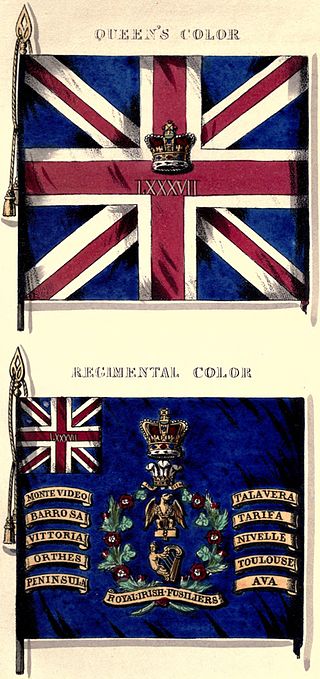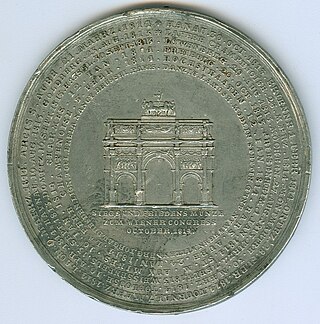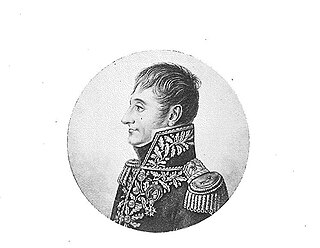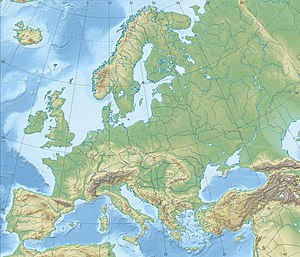
Bergen op Zoom is a city and municipality in southwestern Netherlands. It is located in the province of North Brabant, at the provincial border with Zeeland. In January 2021, the municipality had a population of 67,514.

At the Battle of Fuentes de Oñoro, the Anglo-Portuguese Army under Wellington checked an attempt by the French Army of Portugal under Marshal André Masséna to relieve the besieged city of Almeida.

At the Battle of Roliça, the first battle fought by the British army during the Peninsular War, an Anglo-Portuguese army under Sir Arthur Wellesley defeated an outnumbered Imperial French division under General of Division Henri François Delaborde, near the village of Roliça in Portugal. The French retired in good order.
The Light Division is a light infantry division of the British Army. It was reformed in 2022, as part of Future Soldier reforms.

The 55th Regiment of Foot was a British Army infantry regiment, raised in 1755. After 1782 it had a county designation added, becoming known as the 55th (Westmorland) Regiment of Foot. Under the Childers Reforms it amalgamated with the 34th (Cumberland) Regiment of Foot to form the Border Regiment in 1881.

The Walcheren Campaign was an unsuccessful British expedition to the Kingdom of Holland in 1809 intended to open another front in the Austrian Empire's struggle with France during the War of the Fifth Coalition. John Pitt, 2nd Earl of Chatham, the commander of the expedition, was ordered to capture the towns of Flushing and Antwerp and thus enable British ships to safely traverse the Scheldt River.

The siege of Bergen op Zoom was a siege that took place between September 23 - November 13, 1588, during the Eighty Years' War and the Anglo–Spanish War. The siege took place in the aftermath of the Spanish Armada when famed commander Alexander Farnese, the Duke of Parma attempted to use his forces to besiege Bergen op Zoom, which was held by an Anglo-Dutch force under Thomas Morgan and Peregrine Bertie. An English officer named Grimstone, claiming to be a disaffected Catholic, had set up a trap during which a large Spanish assault was bloodily repulsed. An Anglo-Dutch relief column under the command Maurice of Orange arrived soon after and forced the Duke of Parma to retreat, thus ending the siege.

The 81st Regiment of Foot (Loyal Lincoln Volunteers) was an infantry regiment of the British Army, raised in 1793. Under the Childers Reforms it amalgamated with the 47th (Lancashire) Regiment of Foot to form the Loyal North Lancashire Regiment in 1881.

The 87th Regiment of Foot was an infantry regiment of the British Army, raised in 1793. Under the Childers Reforms it amalgamated with the 89th Regiment of Foot to form the Princess Victoria's in 1881.

In the siege of Ciudad Rodrigo, in Salamanca, Spain, the French Marshal Michel Ney took the fortified city from Field Marshal Andrés Pérez de Herrasti on 10 July 1810 after a siege that began on 26 April. Ney's VI Corps made up part of a 65,000-strong army commanded by André Masséna, who was bent on a third French invasion of Portugal.

The siege of Ciudad Rodrigo was the successful investment of the French-occupied city of Ciudad Rodrigo by Lord Wellington's Anglo-Portuguese Army from 7-20 January 1812. Wellington's army, which numbered up to 40,000 men, faced a small French garrison of 1,800 troops under the command of Jean Léonard Barrié. After two breaches were blasted in the city's walls by heavy artillery units of the Royal Artillery, Ciudad Rodrigo was successfully stormed by British troops on the evening of 19 January. After overcoming the French defenders, the attacking troops went on a rampage for several hours before order was restored. The Anglo-Portuguese Army suffered casualties of about 1,700 men, including two generals killed. Strategically, the fall of the city opened the northern gateway into French-occupied Spain from Portugal.

The Battle of Arroyo dos Molinos took place on 28 October 1811 during the Peninsular War. An allied force under General Rowland Hill trapped and defeated a French force under General Jean-Baptiste Girard, forcing the latter's dismissal by the Emperor Napoleon. A whole French infantry division and a brigade of cavalry were destroyed as viable fighting formations.

The siege of Bergen op Zoom took place during the Austrian War of Succession, when a French army, under the command of Count Löwendal and the overall direction of Marshal Maurice de Saxe, laid siege and captured the strategic Dutch border fortress of Bergen op Zoom on the border of Brabant and Zeeland in 1747. The fortress was defended by Dutch, Austrians, British, Hanoverians and Hessians that supported the Pragmatic Sanction.

General Sir William Anson, 1st Baronet was a British Army officer of the Anson family. Serving in the 1st Foot Guards, Anson saw service in the Flanders Campaign during the French Revolutionary Wars. He assumed command of the 1st Battalion, 1st Foot Guards, during the Napoleonic Wars and commanded it at the Battle of Corunna.

Pierre Dominique Garnier, born 19 December 1756 – died 11 May 1827, was a French general during the French Revolutionary Wars and Napoleonic Wars. He enlisted in the French royal army in 1773 and served in the French West Indies. At the outbreak of the French Revolution he left his career as an architect and joined the National Guard. Continuing in the army, he enjoyed rapid promotion while fighting in several theaters during the War of the First Coalition. As a general of brigade he fought at Toulon and was elevated to the rank of general of division. After fighting at Loano in late 1795, he found himself under the command of Napoleon Bonaparte for the Montenotte Campaign in April 1796. Bonaparte had little use for Garnier, however. Garnier saw action in Italy during the War of the Second Coalition in 1799 and 1800. During the Napoleonic Wars he held reserve or garrison commands and retired from the military in 1816. His surname is one of the 660 names inscribed under the Arc de Triomphe.

The Battle of Hoogstraten was fought on 11 January 1814 between a French army, led by François Roguet, and a Russo-Prussian-British army, led by Friedrich Wilhelm Freiherr von Bülow. The battle, which ended in a Prussian victory, consisted of a series of engagements situated between Essen and Turnhout. The battle was named after Hoogstraten, the main town of the Kempen region.
Major-General John Byne Skerrett was a British army officer who fought in the Peninsular War.

Guilin Laurent Bizanet was a Republican French Revolutionary General who served during the American Revolutionary War, French Revolutionary Wars and the Napoleonic Wars.
The Battle of Courtrai saw Johann von Thielmann's Saxon troops and a few Prussians encounter an Imperial French force under Nicolas Joseph Maison near Kortrijk (Courtrai), a city south-west of Ghent in what is now Belgium. Thielmann attacked only to find himself facing the bulk of Maison's I Corps. The action ended in a rout of the Saxons, most of whom were under fire for the first time.

The siege of Antwerp took place from 14 January 1814 to 4 May 1814, during the War of the Sixth Coalition. Led by Governor Lazare Carnot, Antwerp, then a French city, resisted an Allied siege until Napoleon's abdication and the signing of an armistice.



















